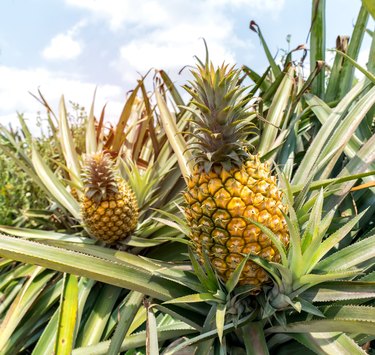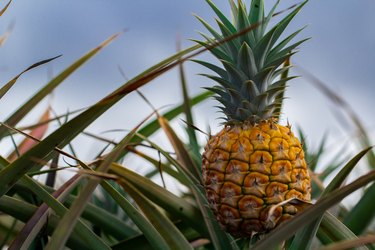A rosette of spiky leaves which can grow as large as 5 feet tall and 4 feet wide, a pineapple (Ananas comosus) plant is a terrestrial bromeliad. A potting mix for pineapple should be an acidic, humus-rich, well-drained, sandy soil with a pH between 4.5 and 6.5. Hardy only in the warm climates of U.S. Department of Agriculture plant hardiness zones 10 through 12, pineapples can be grown as very large houseplants elsewhere.

Video of the Day
Mix Soil for Pineapple Plants
An acidic potting mix intended for cactus, palm and citrus plants should work for pineapples, as it generally contains a fast-draining combination of peat, compost, sand and perlite. If you prefer to make your own mix, combine 1 part all-purpose potting soil, 1 part coarse sand, 1 part peat moss and 1 part leaf mold (composted leaves).
Video of the Day
Prepare a Pineapple Crown
If you plan to start a pineapple plant from a supermarket pineapple, choose a pineapple with a healthy looking crown in spring. Put on gloves and safety googles; the sharp points of the crown may result in a puncture wound and the fresh juice can cause a reaction in sensitive individuals. Slice the pineapple crown off with a sharp knife, cutting about 1 inch below the leaves.
After cleaning the fruit off of that lower 1 inch to leave only its core, strip enough leaves off the bottom of the crown so the bare stem is about 2 inches long. Lay the crown in a dark place for two days to one week, to allow the cut edges to form a callus.
Plant the Pineapple Crown
After the pineapple core has formed a callus, plant in a pot that has several drainage Place a piece of screen mesh or coffee filter paper over the holes to help keep the pineapple potting mix in the pot. Fill the pot to within 1/2 inch of its rim with the lightly moistened mix.
After making a 2-inch deep hole in the center of the potting mix, insert the pineapple core into that hole until the lower part of the crown is resting on the surface of the mix. Tamp the mix around the core, and enclose the pot and crown in a large, transparent plastic bag -- with the bag puffed out or supported by several stakes so it doesn't touch the crown.
Set the pot in a spot where the crown will receive bright, indirect light and temperatures around 70 to 75 degrees Fahrenheit. If its soil is kept lightly damp, the crown should root within four to 12 weeks.

Grow the Pineapple Plant
Once the pineapple plant begins to produce new growth, remove the plastic bag for longer and longer periods of time until the new plant has adjusted to the lower humidity levels, after which you can leave the bag off. Gradually shift the plant to a brighter spot until it is receiving full sun for as much of the day as possible. If possible, move it to a sunny spot outdoors during the frost-free parts of the year, accustoming it gradually to the change in light levels by placing it in a shady location first.
When the pineapple outgrows its pot, transplant it into the next size up, preferably 2 inches larger in diameter. Keep the plant's soil lightly moist while it is actively growing and fertilize it once a month with a balanced organic liquid plant food such as 3-3-3, using 4 tablespoons mixed into 1 gallon of water. Use the solution to water the plant. Check the product label as rates vary by brand. Keep the soil evenly moist for most of the year, and allow the surface of the plant's soil to dry out during winter before you water it again.
A potted pineapple can bloom when it is as young as 1 year old, but it may wait until it is 2 to 3 years old to do so. When mature, it produces a red cone that opens into a 12-inch-tall cluster of 1/2-inch violet flowers, with each bloom surrounded by a bract. The "berries" which follow those flowers eventually fuse together to form a complete pineapple fruit. The new fruits require at least six more months to form and ripen.
